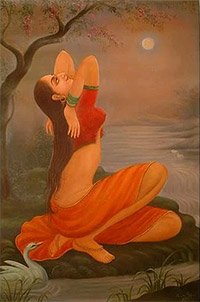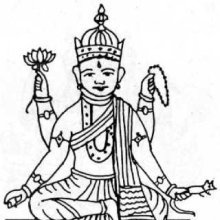Manasi, Mānasī: 14 definitions
Introduction:
Manasi means something in Buddhism, Pali, Hinduism, Sanskrit, Jainism, Prakrit, Hindi. If you want to know the exact meaning, history, etymology or English translation of this term then check out the descriptions on this page. Add your comment or reference to a book if you want to contribute to this summary article.
Images (photo gallery)
In Hinduism
Shaivism (Shaiva philosophy)
Source: Wisdom Library: Kubjikāmata-tantraMānasī (मानसी, “mental”):—One of the nine Dūtī presided over by one of the nine bhaivaravas named Manonmanī (emanation of Ananta, who is the central presiding deity of Dūtīcakra), according to the Kubjikāmata-tantra and the Ṣaṭsāhasrasaṃhitā.
Source: Shodhganga: Temple management in the ĀgamasMānasī (मानसी) refers to a type of dīkṣā (initiation) performed by a healthy Ādiśaiva as part of his essential priestly duties in the Śiva temple.—Dīkṣā is popularly understood as “dīyate kṣīyate iti dīkṣā”—“that which grants mokṣa, while destroying the karma of the initiate”. Mānasī-dīkṣā refers to dīkṣā where the above process [of vācikī-dīkṣā] is done mentally and not verbally.

Shaiva (शैव, śaiva) or Shaivism (śaivism) represents a tradition of Hinduism worshiping Shiva as the supreme being. Closely related to Shaktism, Shaiva literature includes a range of scriptures, including Tantras, while the root of this tradition may be traced back to the ancient Vedas.
Shaktism (Shakta philosophy)
Source: Wisdom Library: ŚāktismMānasī (मानसी):—Name of one of the sixty-four mātṛs to be worshipped during Āvaraṇapūjā (“Worship of the Circuit of Goddesses”, or “Durgā’s Retinue”), according to the Durgāpūjātattva. They should be worshipped with either the five upācāras or perfume and flowers.
Her mantra is as follows:
ॐ मानस्यै नमः
oṃ mānasyai namaḥ.

Shakta (शाक्त, śākta) or Shaktism (śāktism) represents a tradition of Hinduism where the Goddess (Devi) is revered and worshipped. Shakta literature includes a range of scriptures, including various Agamas and Tantras, although its roots may be traced back to the Vedas.
Purana and Itihasa (epic history)
Source: Wisdom Library: Varāha-purāṇaMānasī (मानसी).—Name of a river (nadī) situated near the seven great mountains on the western side of mount Naiṣadha, according to the Varāhapurāṇa chapter 83. These settlements consume the water flowing from these seven great mountains (Viśākha, Kambala, Jayanta, Kṛṣṇa, Harita, Aśoka and Vardhamāna). Niṣadha (Naiṣadha) is one of the seven mountains located in Jambūdvīpa, ruled over by Āgnīdhra, a grandson of Svāyambhuva Manu, who was created by Brahmā, who was in turn created by Nārāyaṇa, the unknowable all-pervasive primordial being.
Source: archive.org: Shiva Purana - English TranslationMānasī (मानसी) refers to a “mental (daughter)”, according to the Śivapurāṇa 2.3.44 (“Menā regains consciousness”).—Accordingly, as Viṣṇu said to Menā: “You are the beloved mental daughter (mānasī—priyā putrī mānasī) of the Pitṛs. You are endowed with all good qualities. You are wife of Himavat himself. Yours is the excellent race of Brahmā. Your well-wishers in the world are also like him (Brahmā). You are really blessed. What more can I say? You are reputed to be a patron of virtue. Why do you then eschew virtue? [...]”.
Source: Cologne Digital Sanskrit Dictionaries: The Purana IndexMānasī (मानसी).—A Dīkṣā.*
- * Brahmāṇḍa-purāṇa IV. 43. 7.

The Purana (पुराण, purāṇas) refers to Sanskrit literature preserving ancient India’s vast cultural history, including historical legends, religious ceremonies, various arts and sciences. The eighteen mahapuranas total over 400,000 shlokas (metrical couplets) and date to at least several centuries BCE.
Kama-shastra (the science of Love-making)
Source: Shodhganga: Elements of Art and Architecture in the Trtiyakhanda of the Visnudharmottarapurana (kama)Mānasī (मानसी) refers to “knowledge of etymology” and represents one of the “sixty four kinds of Art”, according to the Kāmasūtra of Vātsyāyaṇa.—Indian tradition, basically includes sixty four Art forms are acknowledged. The references of sixty four kinds of kalā are found in the Bhāgavatapurāṇa, Śaiva-Tantras, Kāmasūtra of Vātsyāyaṇa etc.

Kamashastra (कामशास्त्र, kāmaśāstra) deals with ancient Indian science of love-making, passion, emotions and other related topics dealing with the pleasures of the senses.
In Buddhism
Tibetan Buddhism (Vajrayana or tantric Buddhism)
Source: Wisdom Library: Tibetan BuddhismMānasī (मानसी) is the name of Vidyārājñī (i.e., “wisdom queen”) mentioned as attending the teachings in the 6th century Mañjuśrīmūlakalpa: one of the largest Kriyā Tantras devoted to Mañjuśrī (the Bodhisattva of wisdom) representing an encyclopedia of knowledge primarily concerned with ritualistic elements in Buddhism. The teachings in this text originate from Mañjuśrī and were taught to and by Buddha Śākyamuni in the presence of a large audience (including Mānasī).

Tibetan Buddhism includes schools such as Nyingma, Kadampa, Kagyu and Gelug. Their primary canon of literature is divided in two broad categories: The Kangyur, which consists of Buddha’s words, and the Tengyur, which includes commentaries from various sources. Esotericism and tantra techniques (vajrayāna) are collected indepently.
In Jainism
General definition (in Jainism)
Source: archive.org: The Jaina Iconography1) Mānasī (मानसी) (or Kandarpā or Paṇṇagādevī) is the name of the Yakṣiṇī accompanying Dharmanātha: the fifteenth of twenty-four Tīrthaṃkaras or Jinas, commonly depicted in Jaina iconography.—[...] Descriptions from the Śvetāmbara books make her ride upon a horse or a fish and appear in sculpture with four hands, adorned with a lotus, goad, lotus and Abhaya. Mānasī, the Digambara variant of the same Yakṣiṇī, is described from their point of view, as riding a tiger, and holding in her six hands a lotus, bow, Varada, goad, arrow and lotus. The origin of symbols, it must have been noticed, is of irregular character. The fish symbol of the Yakṣiṇī seems to be due to the identical symbol of her consort Kiṇṇara as furnished by the Digambara books. It is hardly easy to see any possible connection between her name as Kandarpā and the Brahmanic God, Kandarpa or Kāma.
The name Mānasī has very probable relation with “Manasijā” implying the same idea. Thus, the other name of Paṇṇagādevī or the Goddess of snakes might have been derived from Manasā, who is characteristically a goddess of snakes. Mānasī is also a deity, in the list of the Vidyādevīs and as such, she is interestingly seen to be symbolised by a snake. Her tiger vehicIe, in this instance, shows her a prototype of Vāgīśvarī (goddess of learning) whose figure in Benares shows the same animal as her vehicle.
2) Mānasī (मानसी) also refers to one of the sixteen Vidyādevīs (goddesses of learning).—Mānasī of Śvetāmbara conception has two types in iconography. According to one, she rides a swan and bears the attributes of Varada and Vajra. According to another, she sits on a lion and has four hands carrying Varada-mudrā, Vajra, rosary and again Vajra. The Digambara Mānasī seats herself on a snake vehicle. Mānasī by name and by the symbol of swan, Vajra and lion seems to be based upon a mixture of ideas. The swan symbol is very apt and is in keeping with the traditional emblem of the goddess of learning. The Buddhist deity of learning called Vāgīśvarī, who has a famous temple in Benares rides on a lion. Thus, there must be some undercurrent of interrelation in the symbolism. She rides a tiger. In this case, the Digambara Vidyādevī rides a snake. This appears to be due to the fact of Mānasī and Manasā having the same literal sense.

Jainism is an Indian religion of Dharma whose doctrine revolves around harmlessness (ahimsa) towards every living being. The two major branches (Digambara and Svetambara) of Jainism stimulate self-control (or, shramana, ‘self-reliance’) and spiritual development through a path of peace for the soul to progess to the ultimate goal.
Languages of India and abroad
Sanskrit dictionary
Source: Cologne Digital Sanskrit Dictionaries: Edgerton Buddhist Hybrid Sanskrit DictionaryManasi (मनसि).—(°-) (also manasī-, q.v.)-karoti (= Pali ma-nasi-k°; very rare in Sanskrit, essentially Buddhist word; compare manasi-, manasī-, manas-kāra, which seem not to occur in Sanskrit at all), concentrates the mind on, reflects (intently) on, with acc. (a rare case of gen. s.v. manasī-k°): sādhu ca suṣṭhu ca °kuru Mahāvyutpatti 6315; Saddharmapuṇḍarīka 38.10; 346.6; Sukhāvatīvyūha 5.1; °karoti Lalitavistara 378.16; °kurvanti Saddharmapuṇḍarīka 72.15 (KN printed, as sometimes elsewhere, as two words); °karotha Mahāvastu i.334.1, 2, etc.; °kurvāṇasya Gaṇḍavyūha 504.19; °kariṣyanti Saddharmapuṇḍarīka 478.7; °kartavya Avadāna-śataka ii.140.8; °kṛta (ppp.) Saddharmapuṇḍarīka 60.14; very common, often (as in some of the above) with parallel synonyms like cintayati; especially with yoniśaḥ (or ayoniśaḥ), q.v. for examples.
--- OR ---
Mānasī (मानसी).—name of a kiṃnara-maid: Kāraṇḍavvūha 5.22.
Source: Cologne Digital Sanskrit Dictionaries: Monier-Williams Sanskrit-English Dictionary1) Manasi (मनसि):—[from man] [locative case] of manas, in [compound]
2) Mānasī (मानसी):—[from mānasa] f. (with pūja) mental or spiritual devotion (opp. to mūrti-p, adoration of images), [Religious Thought and Life in India 524]
3) [v.s. ...] Name of a Kiṃ-narī, [Kāraṇḍa-vyūha]
4) [v.s. ...] of a Vidyā-devī, [cf. Lexicographers, esp. such as amarasiṃha, halāyudha, hemacandra, etc.]
Sanskrit, also spelled संस्कृतम् (saṃskṛtam), is an ancient language of India commonly seen as the grandmother of the Indo-European language family (even English!). Closely allied with Prakrit and Pali, Sanskrit is more exhaustive in both grammar and terms and has the most extensive collection of literature in the world, greatly surpassing its sister-languages Greek and Latin.
Hindi dictionary
Source: DDSA: A practical Hindi-English dictionaryMānasī (मानसी) [Also spelled mansi]:—(a) mental, psychic.
...
Kannada-English dictionary
Source: Alar: Kannada-English corpusMānasi (ಮಾನಸಿ):—[noun] a female human being.
Kannada is a Dravidian language (as opposed to the Indo-European language family) mainly spoken in the southwestern region of India.
Nepali dictionary
Source: unoes: Nepali-English DictionaryMānasī (मानसी):—adj. mental; spiritual;
Nepali is the primary language of the Nepalese people counting almost 20 million native speakers. The country of Nepal is situated in the Himalaya mountain range to the north of India.
See also (Relevant definitions)
Starts with (+27): Manacicaiyan, Manashila, Manasi puja, Manasi Sutta, Manasia, Manasia, Manasiba, Manasiga, Manasija, Manasijabrisi, Manasijakride, Manasijaruj, Manasijataru, Manasika, Manasika-aghata, Manasika-gadabadi, Manasika-paksha, Manasika-shalyacikitsa, Manasikabhava, Manasikadura.
Ends with: Bhalamanasi, Gomanasi, Iumanasi, Mahamanasi, Samanasi, Saumanasi, Tanumanaci.
Full-text (+96): Manasija, Manasikara, Mahamanasi, Manasishaya, Manasimandaruj, Manasijabrisi, Manasijataru, Mahamanasika, Manasimanda, Gonama, Manase, Vaishadya, Manas, Manushi, Devya manasi puja, Premapura, Manasikaroti, Kusamusanem, Mamsi, Manacicaiyan.
Relevant text
Search found 68 books and stories containing Manasi, Mānasī, Mānasi, Maanasi; (plurals include: Manasis, Mānasīs, Mānasis, Maanasis). You can also click to the full overview containing English textual excerpts. Below are direct links for the most relevant articles:
Garga Samhita (English) (by Danavir Goswami)
Verse 3.4.15 < [Chapter 4 - The Coronation-Bathing of Śrī Kṛṣṇa]
Verse 4.19.43 < [Chapter 19 - A Thousand Names of Srī Yamunā]
Verse 3.7.7 < [Chapter 7 - The Holy Places of Śrī Girirāja]
Taittiriya Upanishad Bhashya Vartika (by R. Balasubramanian)
Bhajana-Rahasya (by Srila Bhaktivinoda Thakura Mahasaya)
Text 2 < [Chapter 7 - Saptama-yāma-sādhana (Pradoṣa-kālīya-bhajana–vipralambha-prema)]
Text 5 < [Chapter 7 - Saptama-yāma-sādhana (Pradoṣa-kālīya-bhajana–vipralambha-prema)]
Text 4 < [Chapter 7 - Saptama-yāma-sādhana (Pradoṣa-kālīya-bhajana–vipralambha-prema)]
Brihad Bhagavatamrita (commentary) (by Śrī Śrīmad Bhaktivedānta Nārāyana Gosvāmī Mahārāja)
Verse 1.6.108 < [Chapter 6 - Priyatama (the most beloved devotees)]
Verse 2.2.20-21 < [Chapter 2 - Jñāna (knowledge)]
Verse 2.3.147 < [Chapter 3 - Bhajana (loving service)]
Sahitya-kaumudi by Baladeva Vidyabhushana (by Gaurapada Dāsa)
